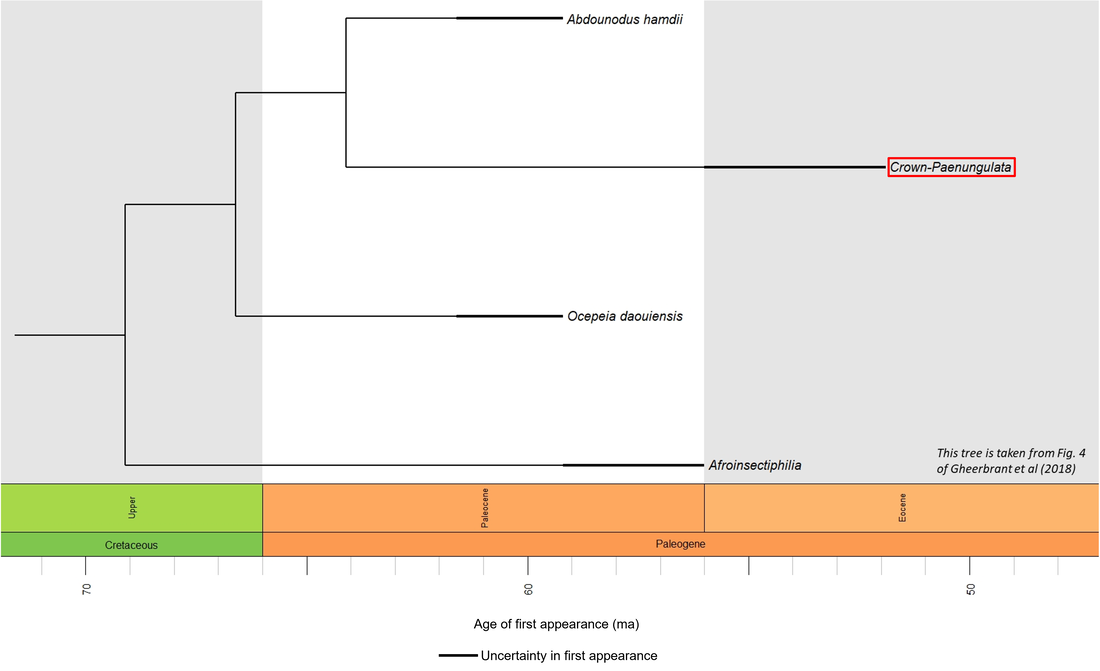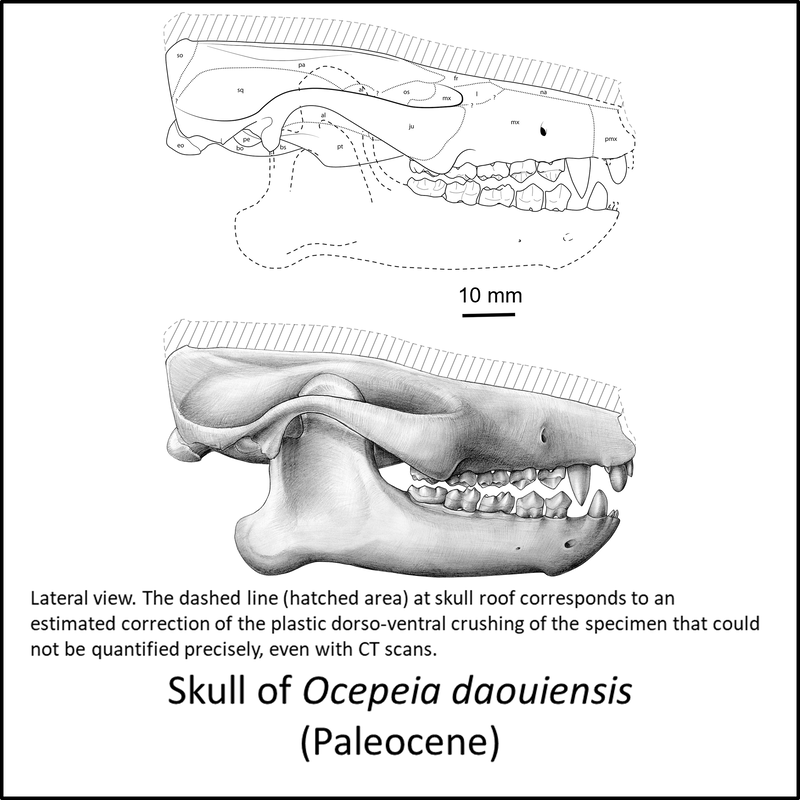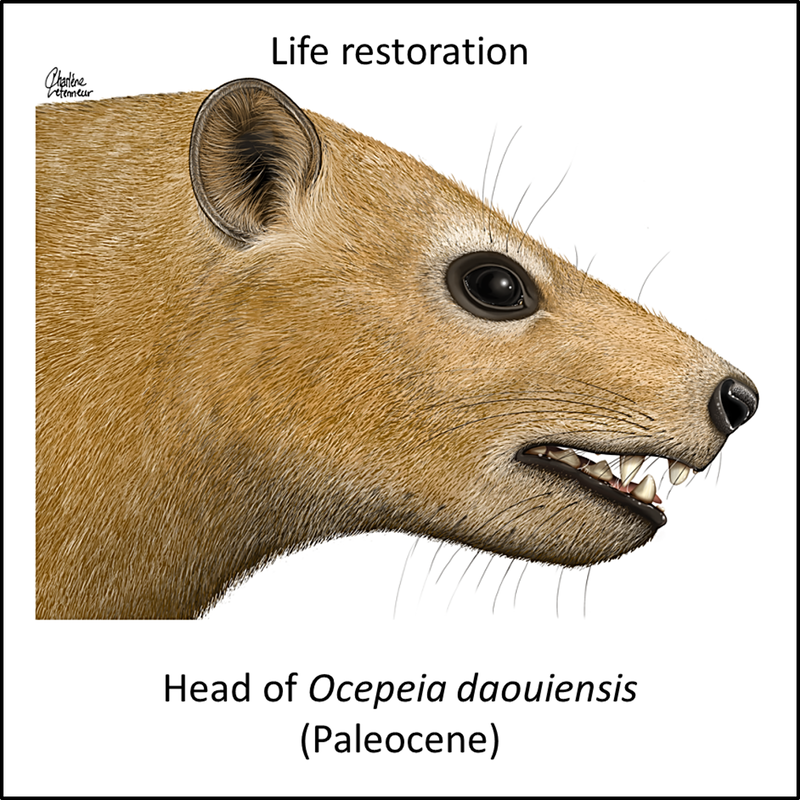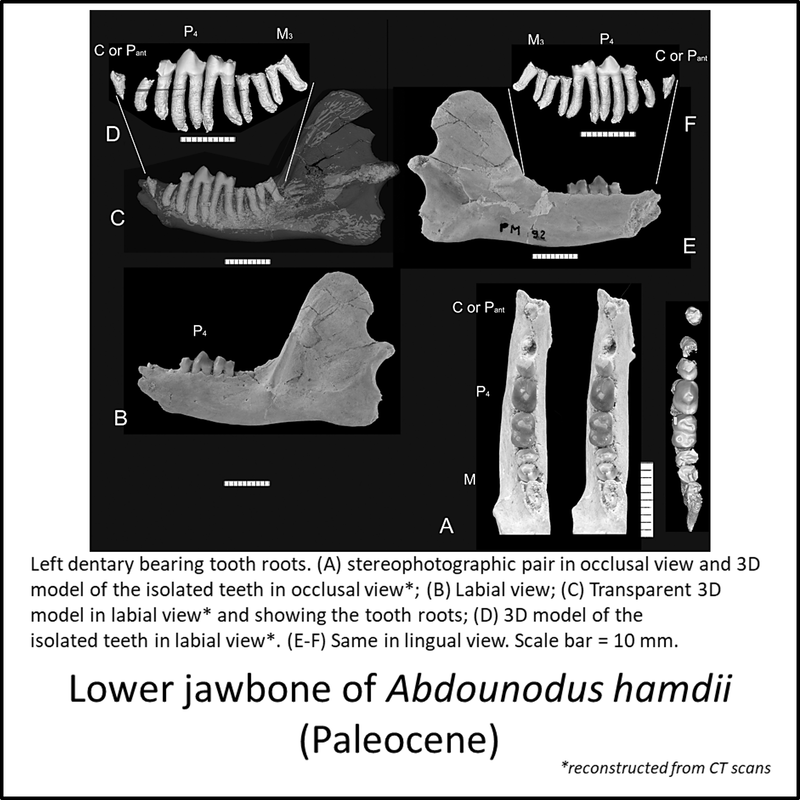The paenungulates (clade Paenungulata, infraclass Eutheria) comprise the clade Tethytheria (the sea cows and the elephants) and the order Hyracoidea (the hyraxes).
To date, only two species have been identified as members of the paenungulate stem group. They are depicted in the following phylogenetic time tree:
To date, only two species have been identified as members of the paenungulate stem group. They are depicted in the following phylogenetic time tree:
Figure 1. Time tree of the stem-Paenungulata
The two known stem-group fossils are Ocepeia daouiensis and Abdounodus hamdii, both described from the Paleocene (Selandian) Bed IIa of the Ouled Abdoun phosphate series in quarries at Sidi Chennane, Morocco (Gheerbrant et al, 2014; Gheerbrant et al, 2016; Gheerbrant et al, 2018). They are illustrated below (click on image for a larger view):
Figure 2. Images of stem-Paenungulata
In contrast to several other taxa (e.g. Eutheria, Theria and Mammalia ), too few fossils of the crown-Paenungulata are available to adequately illustrate the transition from the paenungulate stem group to the crown group.
The available fossil data (see Figure 1 above) indicate that the paenungulate stem group developed from Middle Paleocene to Early Eocene time, representing a minimum stem-to-crown transition period of 3.2 million years.
The available fossil data (see Figure 1 above) indicate that the paenungulate stem group developed from Middle Paleocene to Early Eocene time, representing a minimum stem-to-crown transition period of 3.2 million years.
References
Benton, M. J. (2015). Vertebrate Palaeontology - Fourth edition. John Wiley & Sons, 468 pages.
Gheerbrant, E., Amaghzaz, M., Bouya, B., Goussard, F., & Letenneur, C. (2014). Ocepeia (Middle Paleocene of Morocco): the oldest skull of an afrotherian mammal. PLoS One, 9(2), e89739.
Gheerbrant, E., Filippo, A., & Schmitt, A. (2016). Convergence of Afrotherian and Laurasiatherian ungulate-like mammals: First morphological evidence from the Paleocene of Morocco. PLoS One, 11(7), e0157556.
Gheerbrant, E., Schmitt, A., & Kocsis, L. (2018). Early African fossils elucidate the origin of embrithopod mammals. Current Biology, 28(13), 2167-2173.
Gheerbrant, E., Amaghzaz, M., Bouya, B., Goussard, F., & Letenneur, C. (2014). Ocepeia (Middle Paleocene of Morocco): the oldest skull of an afrotherian mammal. PLoS One, 9(2), e89739.
Gheerbrant, E., Filippo, A., & Schmitt, A. (2016). Convergence of Afrotherian and Laurasiatherian ungulate-like mammals: First morphological evidence from the Paleocene of Morocco. PLoS One, 11(7), e0157556.
Gheerbrant, E., Schmitt, A., & Kocsis, L. (2018). Early African fossils elucidate the origin of embrithopod mammals. Current Biology, 28(13), 2167-2173.
Image credits – stem-Paenungulata
- Figure 2 (Skull of Ocepeia daouiensis, fossil): Open Access article Gheerbrant, E., Amaghzaz, M., Bouya, B., Goussard, F., & Letenneur, C. (2014). Ocepeia (Middle Paleocene of Morocco): the oldest skull of an afrotherian mammal. PLoS One, 9(2), e89739.
- Figure 2 (Head of Ocepeia daouiensis, life restoration): Open Access article Gheerbrant, E., Amaghzaz, M., Bouya, B., Goussard, F., & Letenneur, C. (2014). Ocepeia (Middle Paleocene of Morocco): the oldest skull of an afrotherian mammal. PLoS One, 9(2), e89739.
- Figure 2 (Abdounodus hamdii): Open Access article Gheerbrant, E., Filippo, A., & Schmitt, A. (2016). Convergence of Afrotherian and Laurasiatherian ungulate-like mammals: First morphological evidence from the Paleocene of Morocco. PLoS One, 11(7), e0157556.



